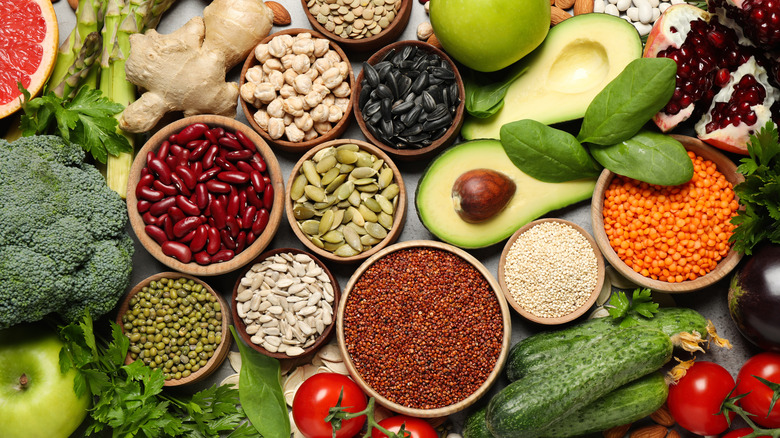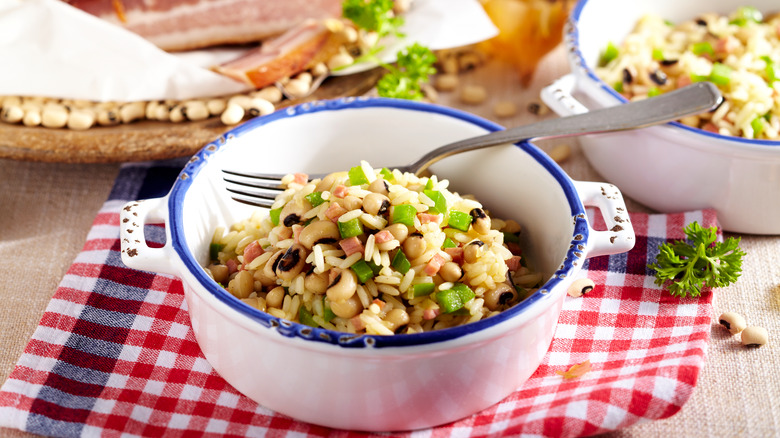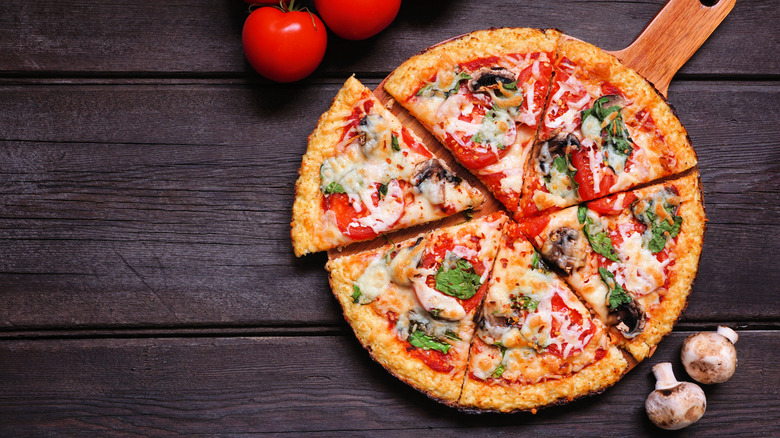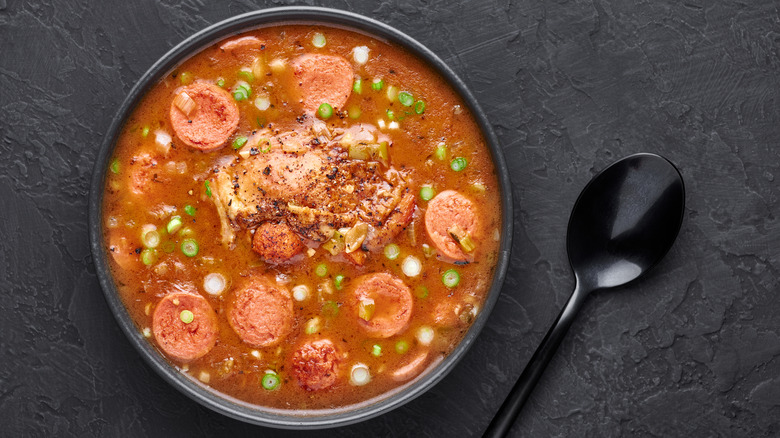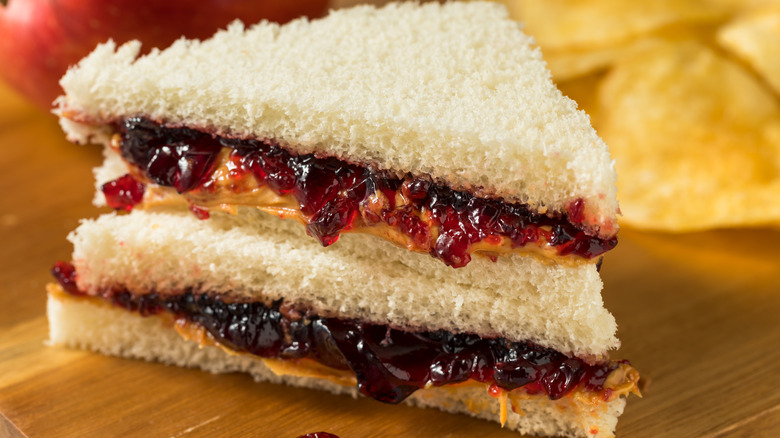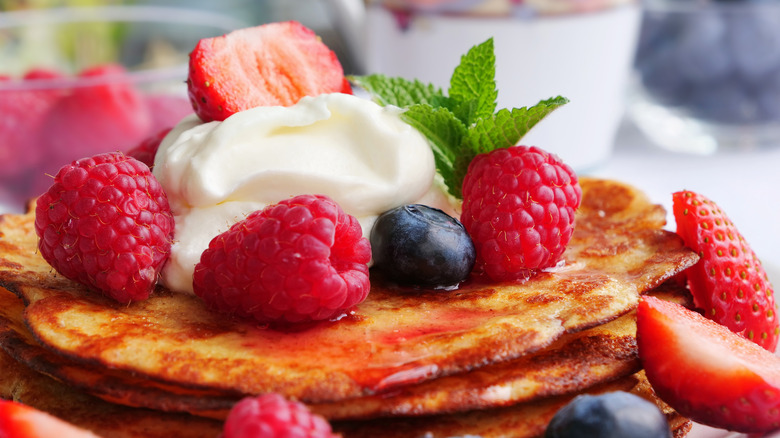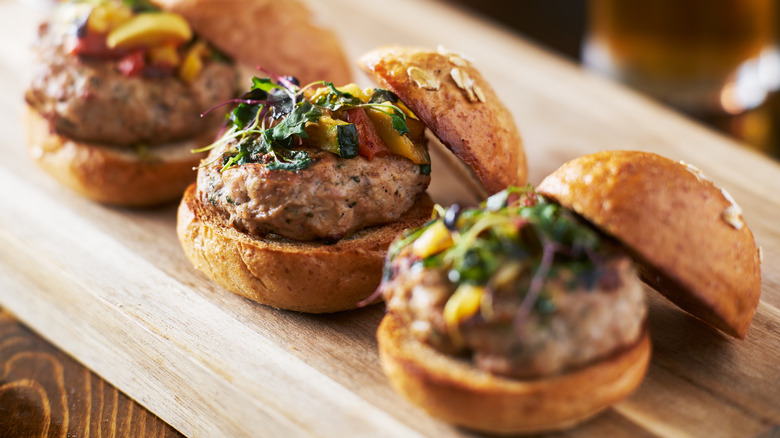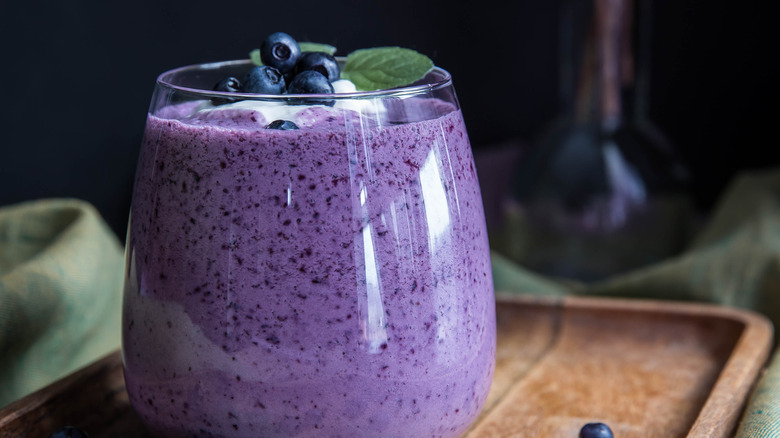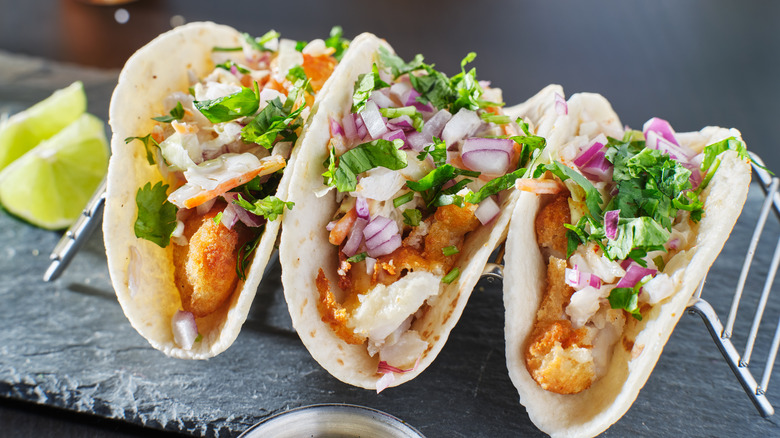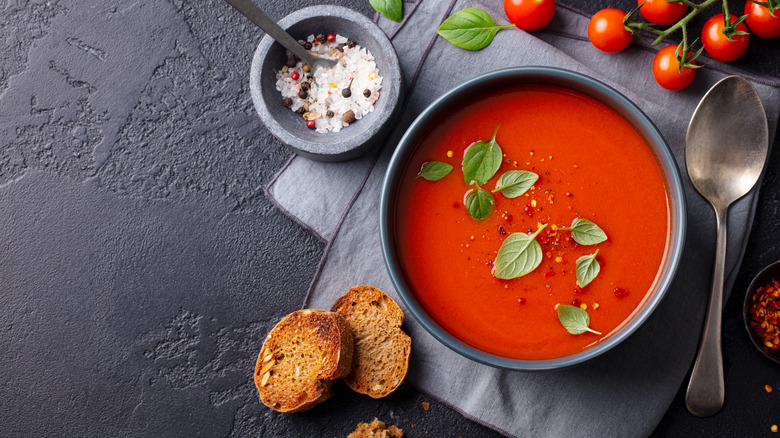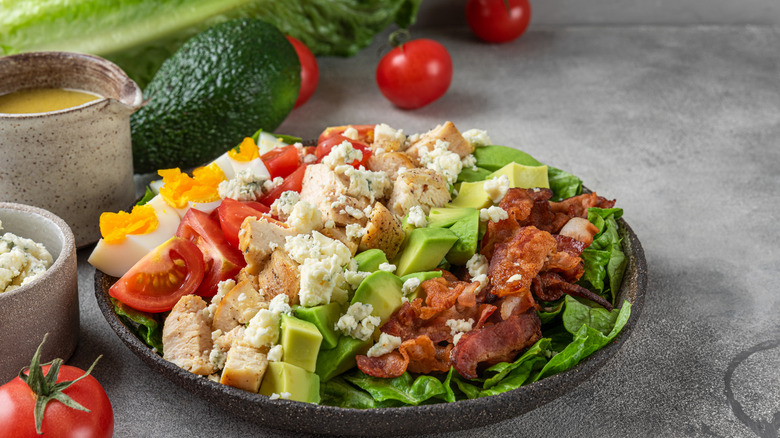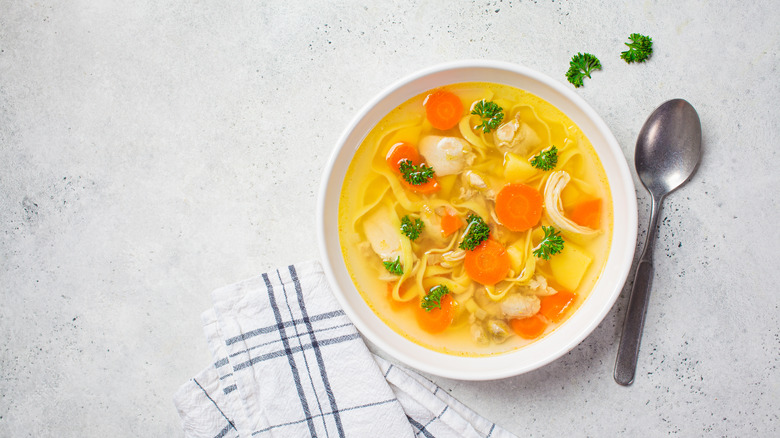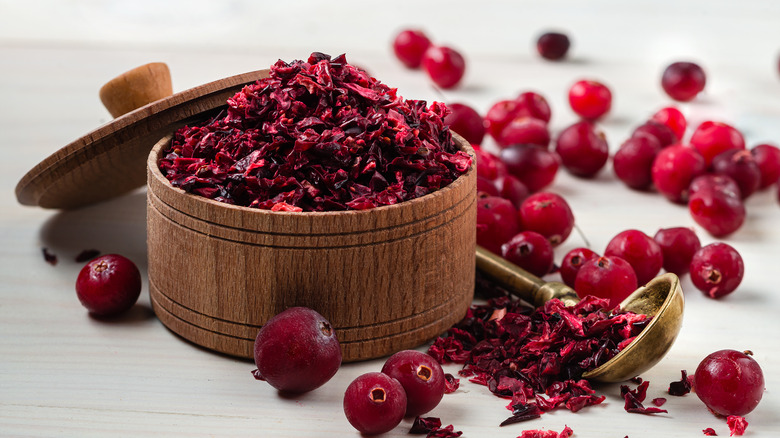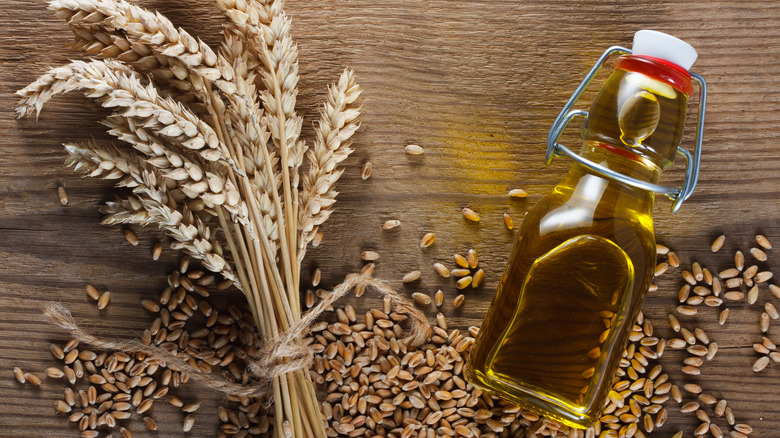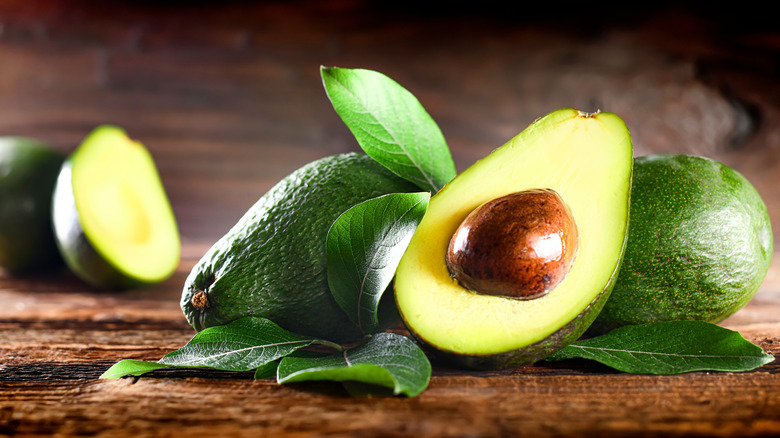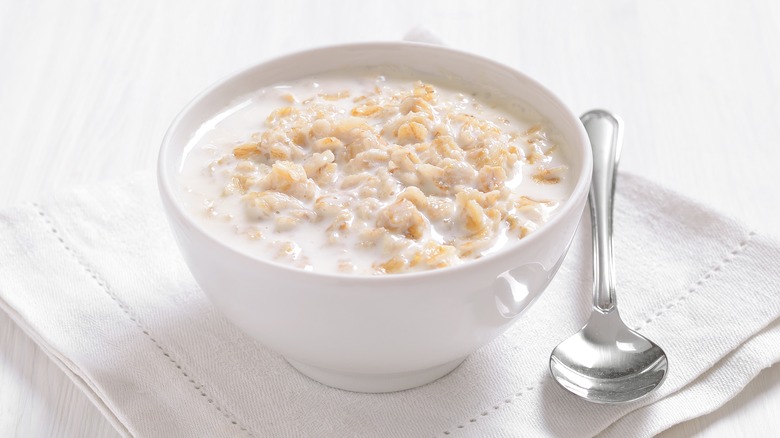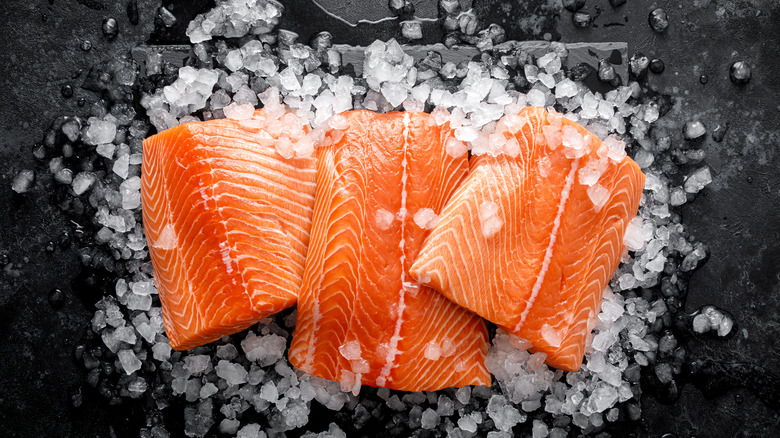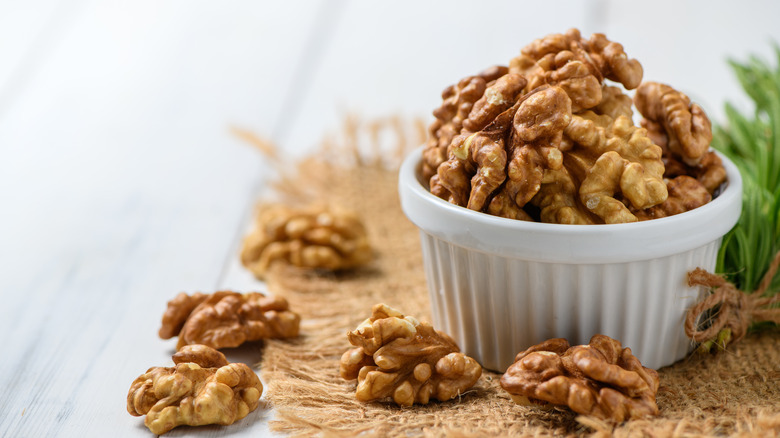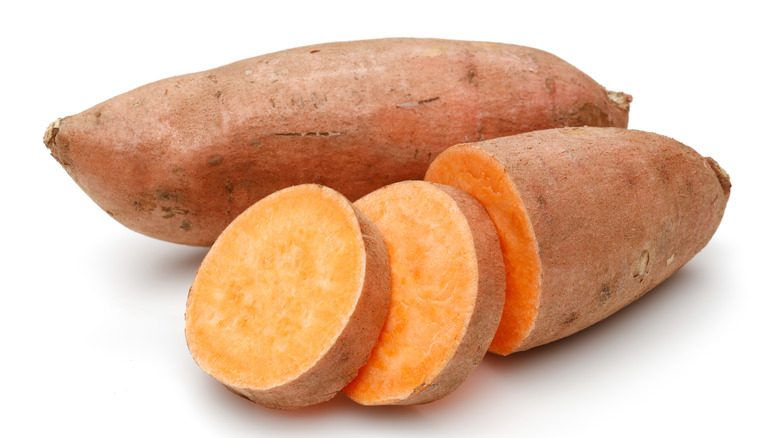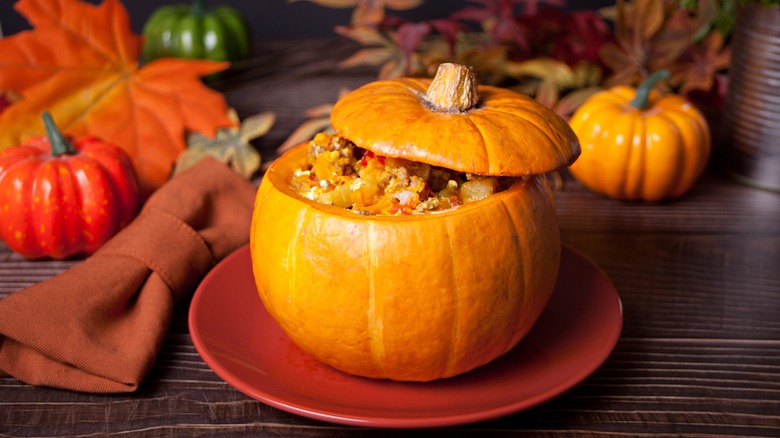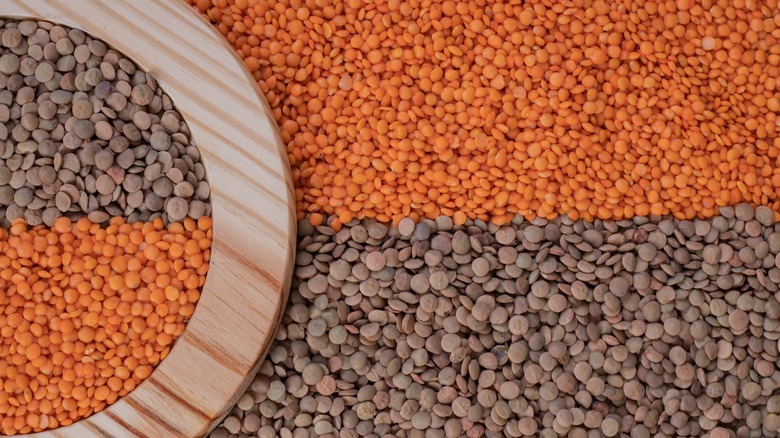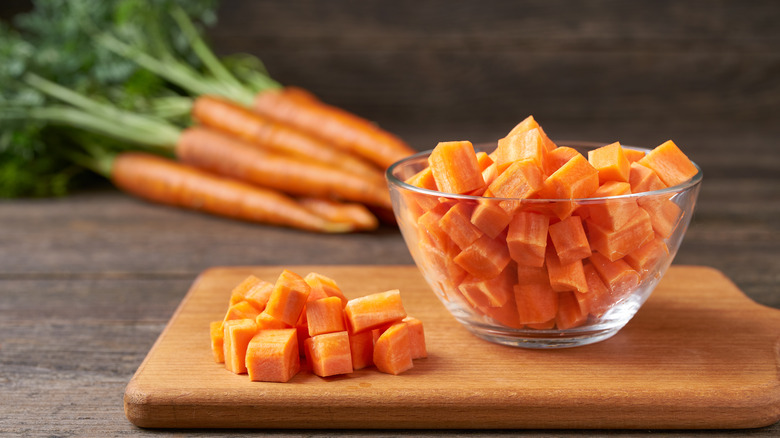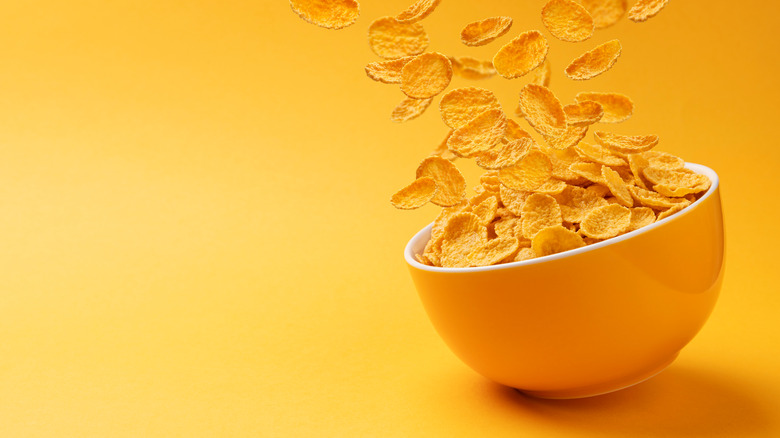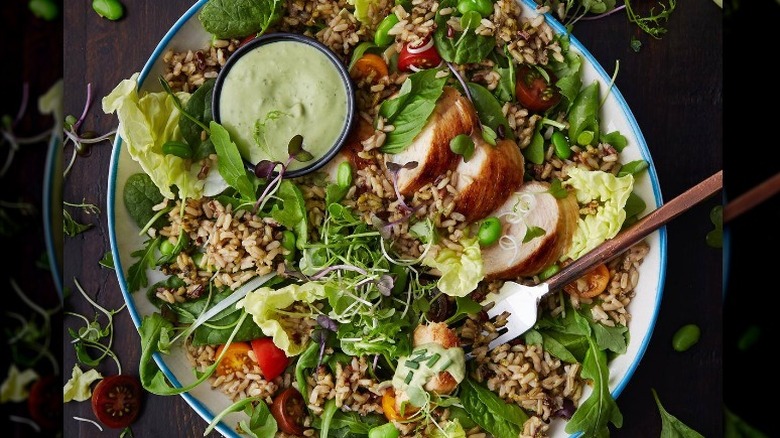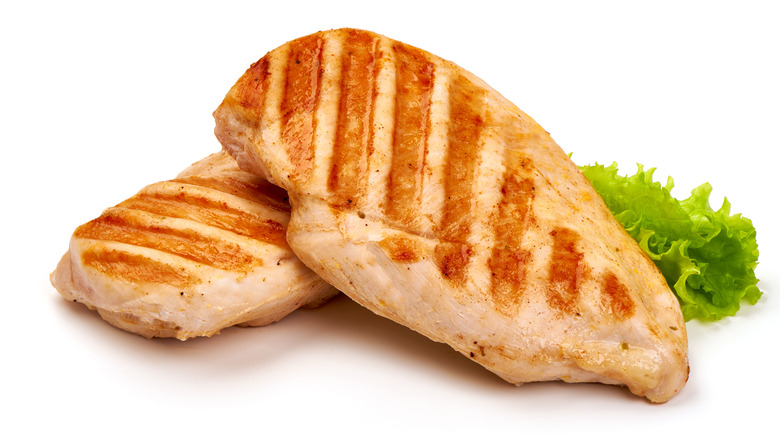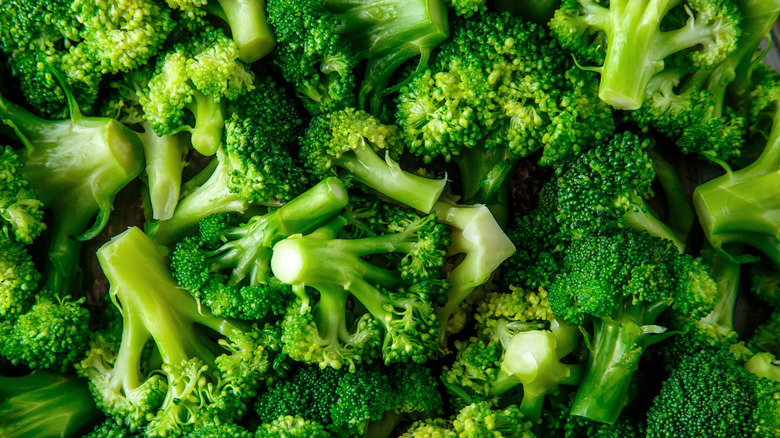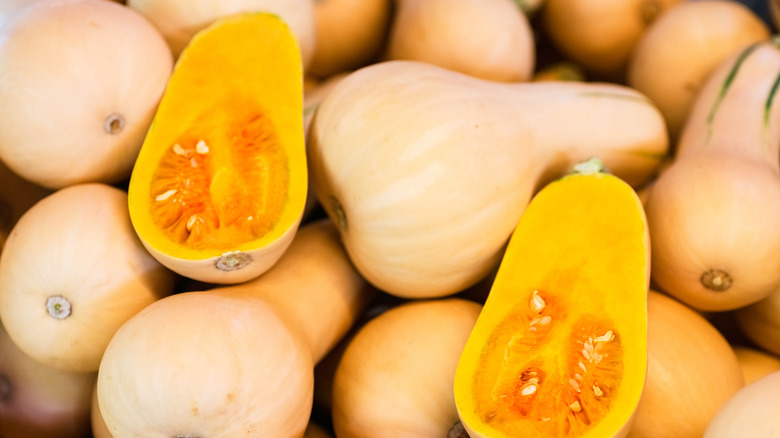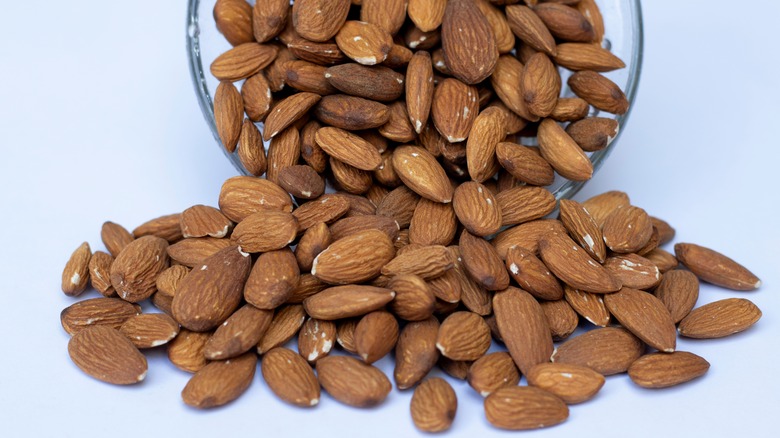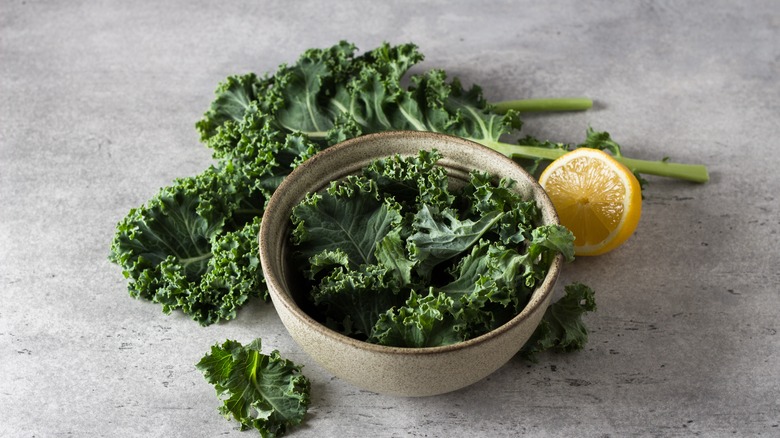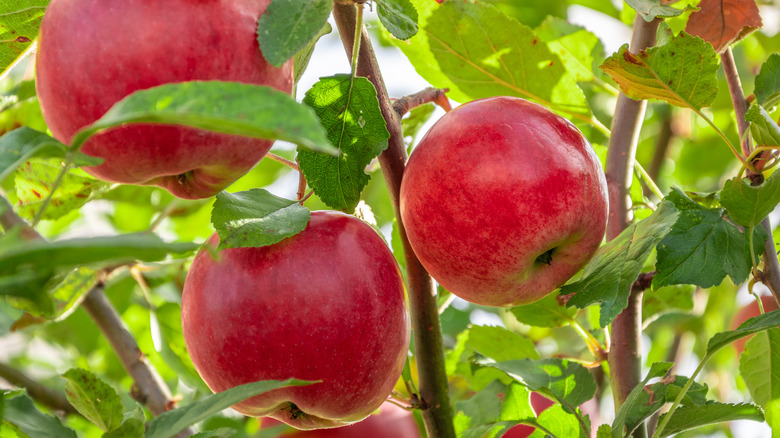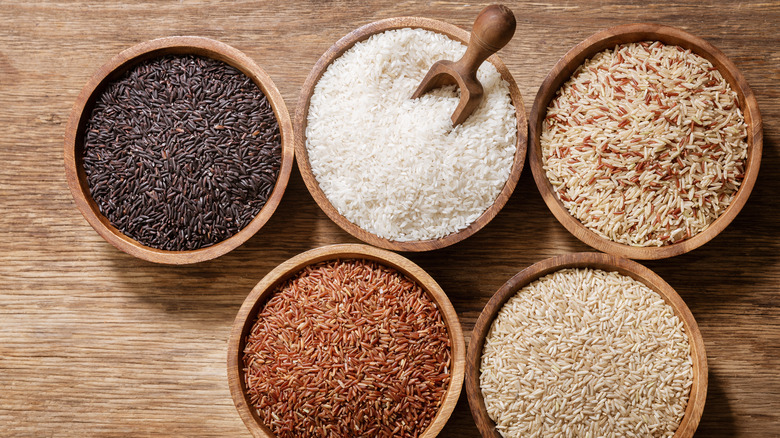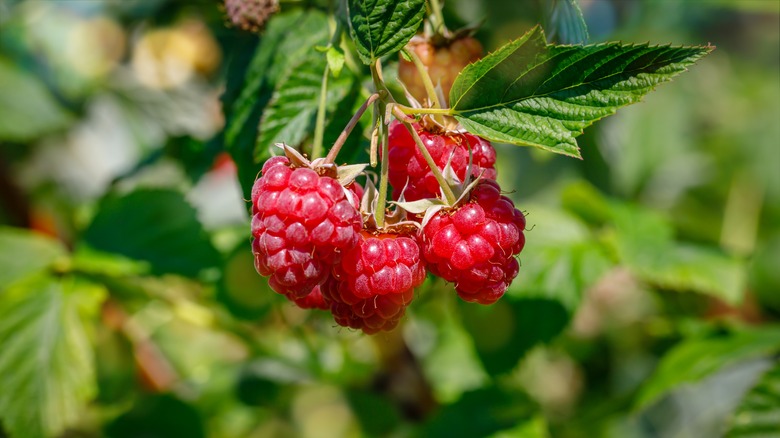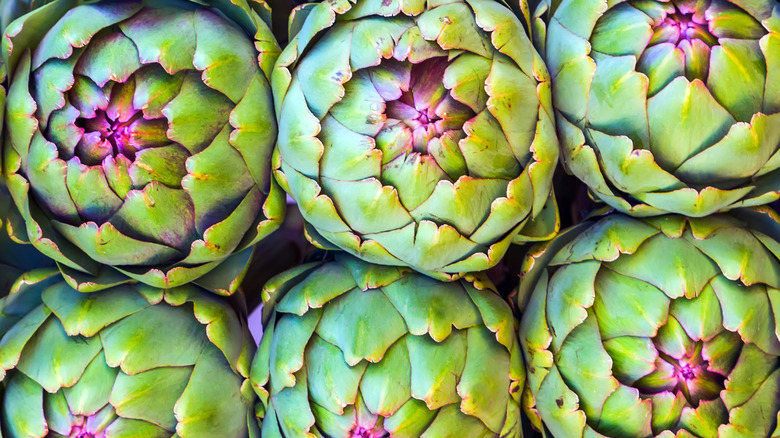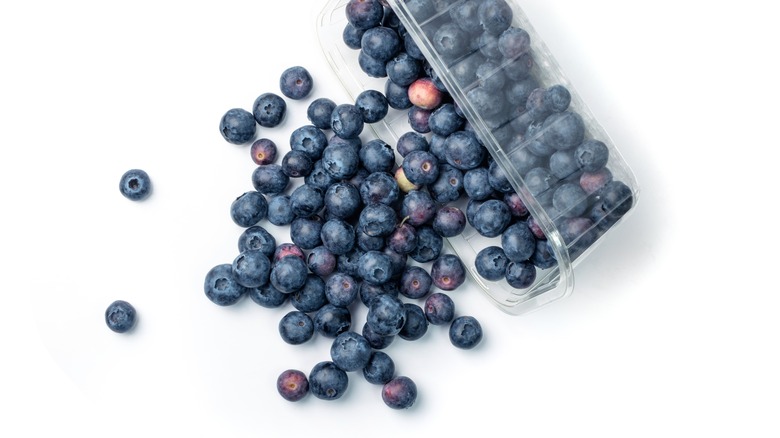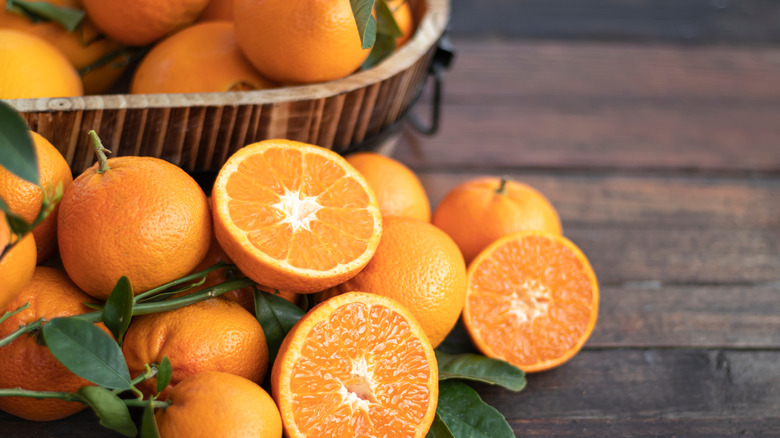37 Healthy American Foods Ranked Worst To Best
Although items like burgers and loaded fries are an important part of the American food scene, there is also a strong health-conscious streak that cooking and eating in the U.S. According to Everyday Health, projected trends like alcohol-free spirits and seeded foods are on the horizon as we enthusiastically champion the next big berry or magic seed pod. However, some stalwart, tried-and-true American dishes and ingredients stand the test of time and continue to deliver significant results, adding nutrients, minerals, vitamins, and boatloads of fiber to our collective diets.
From regional dishes like gumbo and Hoppin' John to glorious bushels of American-harvested apples and cranberries, there is a lot of popular healthy American fare that you can pick up at the supermarket to give your body all the love that it needs. Remember, when picking up your fresh fruit and veggies for the week, it's essential to store them the right way to snack smart all week long.
37. Hoppin' John
Hoppin' John might contain lots of good-for-you peas and veggies, but according to USDA MyPlate, it also contains a high amount of sodium: Nearly 1,000 milligrams per serving. Although there's a fair amount of calcium and potassium in each steaming bowl of Hoppin' John, that does little to offset the massive amount of sodium you'll get from each scoop. Since salt is one of the leading causes of hypertension, limiting your intake of this 'healthy' Southern dish makes smart sense.
According to History, Hoppin' John has deep roots in South Carolina, and the hearty mixture of peas, pork, and rice is the kind of stick-to-your-ribs comfort food that generations of southerners still enjoy today. Like almost all Southern classics, enslaved people from West Africa invented Hoppin' John using a fusion of local ingredients and creating dishes containing flavors inspired by their home countries. Enjoy Hoppin' John, but sparingly.
36. Classic grilled and barbecued fare
While barbecued meats and veggies tend to be less fatty than their pan-seared counterparts (via Medical Daily), this preparation method does come with a significant downside: Possible carcinogens. According to Bon Appétit, that gorgeous campfire taste you get from a perfectly grilled chicken breast could be full of polycyclic aromatic hydrocarbons and heterocyclic amines. At a basic level, these two scientific terms spell nothing but trouble and could even cause cancer (via The New York Times).
Before you toss away your tongs and swear off grilled meats and veggies forever, remember that there is a bit of a silver lining. According to Eureka, people who take their steaks well-done are most at risk, so perhaps it's better to develop a taste for rarer meat if you're going to fire up that grill. Also, as Beaumont points out, grilling or barbecuing meat will remove a lot of the fat content in meat.
35. Grilled cheese sandwich
Ah, the humble grilled cheese sandwich. This gooey delight was a staple food for many American children's diets and still reigns supreme as one of the most scrumptious comfort-food snacks around. The formula is simple; a few slices of bread, some butter, and loads of rich cheese sizzling and sandwiched between the toasty slices. According to Healthline, grilled cheese sandwiches can be healthy thanks to the bevy of minerals and vitamins in the cheese itself. This sandwich will give you a dose of vitamins A and B12, plus protein, niacin, calcium, and riboflavin.
Our bones also love dairy foods so grilled cheese sammies can be a healthy part of a balanced diet. The downside is the high-fat content of the cheese (via Nutritionix). Additionally, the nutritional aspects of the cheese will be dampened by the addition of other ingredients like extra butter, thicker bread, and tasty add-ins like bacon to your sandwich. The verdict: Grilled cheese sandwiches have some health benefits, but they're more of a treat rather than a nutritional powerhouse.
34. Cauliflower crust pizza
Cauliflower pizza crusts are the darlings of the keto craze, and even big-box pizzerias have jumped on board. According to USA Today, Blaze Pizza has introduced a new cauliflower crust to appeal to low-carb pizza enthusiasts. While this veggie-based option might seem appealing, it's not as healthy as you might think.
According to the Cleveland Clinic, cauliflower crusts can be calorie-rich and carb-heavy, even when compared to thin-crust, whole wheat options. Since pizzerias are in the business of creating yummy food to entice return customers, some may also throw in additional fats or cheeses into their crusts. While this option may be keto-friendly, that in itself does not make cauliflower crusts a healthy food.
Ultimately it's best to read the ingredients and make an informed choice. With so many cauliflower crusts on the market, including options from Trader Joe's and other specialty shops, you can choose the healthier option that won't kick you out of ketosis.
33. Gumbo
Rich, hearty gumbo gets a healthy kick from an oft-overlooked vegetable, okra. According to Healthline, okra is packed with tons of vitamins, like K, C, A, and B6. It also has plenty of magnesium and not too many calories or carbs. Your simmering bowl of gumbo also masks okra's notoriously slimy texture, which some folks find utterly unappealing (via Sustainable Food Center). In addition to the okra, gumbo has plenty of tomatoes and peppers, making up the bulk of this Creole classic and giving it a decidedly healthy bent.
Unfortunately, gumbo is highly caloric, clocking in at up to 450 calories per one-cup serving thanks to its fatty roux base and meat (via Livestrong). Gumbo tends to have big old hunks of sausage in it. While tasty, this sausage kicks gumbo into more of the comfort food category than the certified health food one. Enjoy gumbo as a special treat, but don't trick yourself into thinking it's doing your body too many favors.
32. Peanut butter and jelly
Childhood classic peanut butter and jelly is one of the most iconic foods that is steeped in American wholesomeness. PB&J is the tried and true combination of velvety peanut butter, sweet fruity jam or jelly, and hearty bread that's beloved by kids and, according to ESPN, even NBA players
According to Healthline, this combo is pretty good for you. Peanut butter keeps you full, thanks to a big boost of fiber and plenty of good-for-you fat. Jellies and jams are natural prebiotics that aid digestion and quell stomach problems.
The trick to transforming this sandwich from tasty childhood staple to health food lies in the ingredients. Jellies can be super sugar-rich, so opting for a low-sugar or homemade blend can cut back on the overall sugar content of your sandwich. Whole wheat bread is a better option than white bread and can sneak in some extra nutrients as well (via CNN).
31. Keto Pancakes
Keto pancakes eschew traditional flour for non-wheaty alternatives that let you have your favorite breakfast flapjacks and stay well within your carb count. According to King Arthur Baking, keto pancakes are gloriously versatile. You can make traditional stacks, mini-pancake cereal, or use the pancakes as a base for sweet or savory breakfast wraps. Unfortunately, while keto pancakes can be healthy, they're also part of a diet that can skew towards being notably unhealthy if you're not careful.
According to Forbes, the aim of keto diets is to put your body into ketosis, where it furiously burns excess fat stores for fuel. This ketosis makes the pounds melt off; however, ketogenic diets come with a slew of cautionary warnings. Since keto diets are notoriously high-fat, you risk not consuming enough nutrients since vegetables and fruits are not typically consumed as part of a keto diet. For maximum health benefits, pair your keto pancakes with low-carb fruits for a balanced and nutritionally viable meal (via Healthline).
30. Turkey Burgers
Although turkey burgers might seem like a logically healthy alternative to beef-based ones, the truth is a bit more complicated (via Men's Health). It all comes down to the meat itself. Turkey breast is a good pick, but plenty of ground turkey burger mixes have dark meat mixed in, which bumps up the fat content and actually makes the burgers fattier than leaner cuts of ground beef. So check the package's composition beforehand if you're sizzling up a turkey burger at home.
Burgers at restaurants are associated with different challenges, like fatty add-ons to keep the result tender and juicy (via Men's Health). Also, according to Houston Methodist, there are some real upsides to opting for a traditional beef burger, like zinc and iron, although turkey doesn't have the high saturated fat count of its red meat counterparts. So if you want a healthy turkey burger, go for breast meat and cook it up sans the unhealthy toppings.
29. Smoothies
According to Leaf TV, the idea for smoothies originated from similar drinks in India and Latin America. Today, this cherished breakfast staple is nearly synonymous with health food, but the jewel-toned look of these smoothies can be deceiving. Although smoothies can and often are healthy, they can also be glorified milkshakes masquerading as liquid health food.
According to The New York Times, you never know what's lurking in a commercial smoothie. The smoothie game is focused on creating a good-tasting drink, not necessarily delivering loads of nutrients and vitamins. Different kinds of butter, milk or even ice cream may be lurking beneath all that fruit.
In fact, the popular chain Smoothie King has a drink that tops out at a whopping 890 calories. It's easy to regulate your calorie intake at home by avoiding ice cream and sticking to frozen fruit (via NPR). If you go the smoothie route, it's best to do so from the comfort of your own kitchen.
28. Fish tacos
Fish tacos might seem like a refreshing and nutritious alternative to carnitas, beef, or chicken tacos, and they certainly can be. According to Healthline, fish has plenty of omega-3 fatty acids and can be less of a catastrophic calorie bomb than tacos with traditional beef, pork, or chicken taco filling.
Fish tacos will still give you a healthy dose of protein, so they're a fantastic option for people who want to get their taco fix and forgo a lot of extra fat and calories. There's one caveat, though: While the fish itself may be healthy, the toppings can tip the scales dramatically towards far too rich. For a super healthy and light taco, go easy on the sour cream, guacamole, and shredded cheese.
Although you can certainly make fish tacos at home using the fish of your choice and whole wheat tortillas, there's likely a tasty taco option near you. These absolute best fish tacos in the United States are true must-tries for any TexMex connoisseur.
27. Tomato Soup
Tantalizing, soul-warming, rich, and hearty tomato soup is easily one of the best comfort foods on the planet, and it certainly can be healthy. According to Healthline, tomato soup has plenty of vitamins A, C, and K, plus a solid dose of potassium and lycopene. Lycopene is a heart-health-boosting antioxidant that may even ward off cancer (via Healthline). Thanks to its main ingredient, tomato soup is brimming with this lycopene.
Although tomato soup has some seriously tremendous upsides, it does have a downside, mainly in the sodium department. According to Livestrong, tomato soup's roster of health-boosting ingredients is accompanied by a ton of sodium, especially in the canned, store-bought varieties. Fortunately, it's easy enough to solve the sodium dilemma by simply making the soup at home and regulating the salt content yourself. This 15-minute tomato soup recipe is a great start and will give you a delicious bowl in no time.
26. Skinny Cobb Salad
Cobb salad can be a double-edged sword. On the one hand, all those great veggies are full of nutrients and vitamins. On the other hand, the traditional French dressing is super fatty. Limit the dressing and up the veggies, and you're well on your way to a hearty, healthy, satisfying meal. According to Livestrong, Cobb salads get their protein punch from eggs, lean protein, and cheese. Most recipes call for bacon, but if you're looking to cut back on your sodium and fat, you can certainly omit it.
Most of the nutritious Cobb salad ingredients sit atop a bed of fibrous and nutritious lettuce, which is both calorie-light and full of vitamin A. Swap out iceberg for spinach or romaine, and you'll get a kick of vitamin K and some more iron. Additionally, silky avocado and juicy tomatoes bring lycopene and the good fats. Cobb salad can be a complex celebration of different healthy ingredients, and if you add the dressing sparingly, it's a perfectly nutritious option.
25. Chicken Noodle Soup
You might think of chicken noodle soup as the ultimate "feel better" food. According to Insider, it's not just a placebo effect. Chicken noodle soup has rich, super-healthy bone broth, lean meats, and tender vegetables. These components bring something lots of nutrients to the table, including a host of B vitamins, amino acids, antioxidants, fiber, and vitamin C. In short, chicken noodle soup is delicious medicine, and it's a good option for when you're feeling under the weather or just want a healthy and filling lunch.
Chicken soup's major Achilles heel is sodium. Canned chicken noodle soup has oodles of sodium, and while you'll still get a lot of healthy benefits, the salt shock is not good for you. So to avoid saturating your body with tons of unwanted sodium, make up a quick batch of chicken noodle soup at home with this copycat Panera chicken noodle soup recipe.
24. Cranberries
According to the Cleveland Clinic, tart and tangy cranberry juice can ward off urinary tract infections, keep your mouth cavity-free and possibly even help regulate your blood pressure. Additionally, these crimson berries have plenty of vitamins, like K, E, and C, as well as manganese and fiber.
Although they've got a super-sour flavor and aren't palatable when raw, cranberries can be a welcome part of smoothies or reduced sugar juices. Processed cranberry foods tend to be higher in sugar, so if you don't want to balance their nutritional heft with a big sugar high, opt for the non-processed stuff.
According to APS, cranberries were born and continue to be bred in North America. Giant swatches of the country are ripe for cranberry planting, making it one of the country's top fruits. On the flip side, cranberries are not great for people who are prone to kidney stones or taking certain medications.
23. Wheat Germ
According to Healthline, wheat germ is a hyper-concentrated, nutrient-packed super supplement with plenty of fiber, minerals, and good fat. It's a top source of vitamin E, a nutrient with antioxidant effects that are crucial for radiant and hydrated skin (via Cleveland Clinic). Wheat germ's charms aren't just skin-deep, though. This incredible super supplement may help your body's natural immunity, cholesterol levels, and heart health.
Wheat germ could be especially beneficial for people about to enter or in menopause, although the research is inconclusive. What does seem apparent, though, is that wheat germ is an undeniably healthy addition to your overall diet.
The only downside is that some people might suffer from gas, nausea, or lightheadedness after ingesting wheat germ (via Healthline). If you notice some not-so-pleasant side effects from your wheat germ supplement, it's a good idea to stop taking it immediately and talk to your healthcare professional.
22. Avocados
According to the Agricultural Market Resource Center, avocados have been flourishing in Florida and California since the mid-1800s. Today, the Golden State supplies most American avocados, although Florida and Hawaii do give California a run for its money.
Avocados are not only delicious, but they're also high in healthy fats and nutrients. According to Medical News Today, avocados contain loads of vitamins B6, K, C, and E. Every slice of this creamy green fruit also has tons of folate, magnesium, and potassium.
Although it's certainly okay to incorporate avocados into your diet, remember that these healthy treats do contain a lot of fat (via Cleveland Clinic). It's the good kind of fat; however, too much fat can still have adverse effects on your health.
Also, avocados are a notoriously finicky fruit known for going from ripe to rotten with lightning speed. So save yourself the drama and learn how to tell if an avocado has gone bad before buying them.
21. Oatmeal
According to the Herald-Mail Media, oatmeal is a classic American pantry staple. It's easy to understand why; oatmeal takes on the flavor of anything you mix in, it's relatively inexpensive and really quite healthy. Plus, oatmeal is a godsend for people who are sensitive to gluten. Oatmeal is available in different varieties, from hearty steel-cut oats to quick-cooking instant oatmeal.
One serving of oatmeal can keep you full for hours, thanks to the superstar duo of fiber and protein (via Web MD). It can help regulate your bowels and keep your tummy happy, too, making this food a good choice for people with IBS or other digestion-related troubles.
But, as with most health foods, oatmeal does have a grim side. While it might be fun and tempting to load up your oats with tons of different toppings, packing on the nuts, sugar, and fruit can tip a bowl of oatmeal from a satisfying yet light meal to an overly filling one (via Health Digest).
20. Salmon
According to Healthline, salmon absolutely dominates in the nutrition department thanks to its nutrient-heavy composition and a colossal amount of omega-3 fatty acids. Not only is salmon delicious, but it's also exceptionally versatile.
Top your bagel with paper-thin slices of smoked salmon for extra flavor and texture, or savor a beautifully poached and garnished salmon filet for dinner. Wild salmon is preferable to farmed salmon in taste and nutritional makeup. Both have selenium, inflammation-busting omega-3 fatty acids, and plenty of vitamin B12.
The reason why this stellar swimmer isn't higher on our list is simple: Overfishing. According to AP News, climate change and overfishing are doing a number on native salmon populations and disrupting natural spawning patterns. As a result, salmon populations are dwindling dramatically. So if you partake in this healthy and delicious fish, do so sustainably and responsibly by making sure you know exactly where your fish is coming from.
19. Walnuts
According to Encyclopedia Britannica, cultivation in North and South America produces English walnuts, a hearty and tasty nut that Americans love to snack on. Walnuts are highly healthy nuts, and regular consumption might just help you keep cancer at bay and protect your heart and brain (via Healthline).
Walnuts can control your cholesterol and fight off inflammation thanks to their potent combination of antioxidants and fats. Plus, they're tasty, and you can incorporate them into virtually any savory or sweet dish, including salads, pasta dishes as well as soups.
Although there's a lot to love about walnuts, there are a few bummers too. According to Healthline, many people have mild to serious walnut allergies, and the nuts themselves might impede nutrient absorption, due to the fact that they contain phytic acid. Although very severe allergies and nutritional problems are rare, the possibility of a reaction makes walnuts a risky food.
18. Sweet potatoes
According to the Agricultural Marketing Resource Center, North Carolina supplies the country with the majority of sweet potatoes Americans consume. These orange-hued southern treats are impressively healthy and delicious, and each delicious spud provides a massive amount of vitamin A. Additionally, according to Very Well Fit, sweet potatoes are pretty much fat-free. They have a low amount of sugar, making them ideal dinner companions for your steak or grilled salmon entrée.
Sweet potatoes are arguably more nutritious than white or yellow ones (via Insider). However, people prone to kidney stones might want to tread lightly around these vibrant spuds. According to The Times of India, sweet potatoes have plenty of oxalate, which might trigger or irritate the symptoms of kidney stones. So if you've had kidney stones in the past or have a familial history of them, you might want to steer clear of large quantities of sweet potatoes, or at least talk to your doctor before consuming them.
17. Pumpkin
Pumpkin is a super squash that grows in North America, and it plays an integral part in both cuisine and culture (via Healthline). Although pumpkins can be used to make amazing Halloween decorations, they're even better in side dishes and meals.
They top the nutrition charts with an array of different vitamins, copper, fiber, iron, vitamin K, vitamin A, magnesium, and potassium. Just don't get them twisted up with another sweater-weather fave, the decadently sweet pumpkin spice lattes: They bear precisely zero resemblance or nutritional value to the fruit itself (via PopSci).
Pumpkins are almost entirely edible, and although people don't generally snack on the leaves, they certainly could. However, while toasted pumpkin seeds are a source of joy for many pumpkin enthusiasts, too much of a good thing could be, well, too much. According to Health Shots, eating too many pumpkin seeds might just leave you with tummy trouble later on.
16. Lentils
According to the USA Dry Pea Council, the Northwestern states provide hungry Americans with the vast majority of their lentils. These tiny legumes have over 15 grams of fiber per serving, plus plenty of other goodies, including 90 percent of your recommended daily folate intake (via Healthline). The fiber is really what lets them punch above their humble weight. Eat lentils, and you'll be full for hours; plus, they contribute to digestive health and might even shield you against severe conditions like diabetes.
Furthermore, lentils are highly versatile. You can eat them in soups, as well as savory dishes that contain lentils and rice. You can even swap out meat and replace it with lentils on Meatless Monday or any time you want to cut back on animal protein. Just make sure you cook your lentils completely before consuming them, even in cold dishes. You should never eat raw lentils because they contain lectin, a gut-wrecking protein that could make you ill.
15. Carrots
According to Food Manufacturing, carrots are America's most beloved vegetable showing up in baby food jars, regular grocery lists, and dinner tables throughout the country. Not only are they familiar and comfortable, but they're super healthy too. Carrots can do wonders for your immune system, supporting antibodies and iron absorption thanks to their copious amount of vitamin C (via Web MD). If you're having tummy troubles, carrots can come to the rescue, too, helping you stay regular thanks to their fibrous composition.
Is there anything carrots can't do? Unfortunately, as it turns out, too many carrots might send you on a one-way ticket to Oompa Loompa Land. Carrots have vast stores of beta-carotene, which can stain skin over time, causing Carotenemia (via Web MD). The good news is, Carotenemia is easy to treat, relatively harmless, and aside from your yellow-orange hue, you won't even notice any pain or discomfort.
14. Cornflakes
According to Taste Atlas, John Harvey Kellogg came up with cornflakes in 1894 in a bid to reign in self-love. While we're not sure if it worked or not, what is true is that cornflakes have taken the United States and plenty of the world by storm. Whether you enjoy them plain or floating in milk, there's an excellent chance you've enjoyed cornflakes for breakfast, as a snack, or for a rushed dinner when there wasn't anything else in the fridge.
Cornflakes are iconic Americana, and they're also super healthy for you. According to ABP Live, cornflakes are quick to prepare, full of vitamins, and very low in calories. This triple health action makes them one of the top health foods in the country. Not only can you pour yourself a bowl in a matter of minutes, but you'll also be chowing down on vitamins B12, B, and A, plus lutein and niacin.
13. Green Goddess salad
Green Goddess salad is as veggie-heavy and decadent as it sounds, with plenty of nuts, vegetables, and a silky, luxurious dressing that can be made completely vegan. According to Shape, Green Goddess salads are herbaceous and hearty, and digging into one lets you soak in all of the nutrients from different components.
TikTok's trendy vegan Green Goddess salad went viral in 2022, wowing fans with its creamless, silky dressing and bevy of different ingredients. Apparently, even music royalty like Lizzo can't get enough of it.
If you want to keep your Green Goddess salad tasty and light in calories but don't want to go completely vegan, you can always whip up the Green Goddess dressing with Greek yogurt, as opposed to the more traditional sour cream or mayonnaise. However, if you really want to treat yourself, make a classic Green Goddess salad dressing and use it sparingly.
12. Chicken breast
According to BNN Bloomberg, the American love affair with chicken breast is dwindling, and chicken thighs are coming into fashion thanks to changing palates. However, that slight shift in popularity doesn't mean that this staple is going the way of the Dodo bird anytime soon. As Very Well Fit points out, chicken breast is still a terrific low-fat meat option that can help you gain and keep muscle. It also keeps you full for the long haul and helps fortify your bones, leading to a stronger body overall.
Although chicken breast is undeniably effective in keeping you full and giving your body plenty of protein, it can also skew towards being a bit boring. So liven it up with these 63 chicken breast recipes that you'll want to put into your regular rotation. With a little bit of love, seasoning, and prep work, chicken breast can truly shine and make your dinner extra special.
11. Rice and Beans
According to Consumer Reports, rice and beans is a dish that is exceptionally good for you, thanks to its hearty dose of veggie-based protein as well as tons of fiber. This classic dish from the American South is incredibly filling and tasty, due to its long simmer time and the tried-and-true combination of beans and delicate rice.
One of the key ways to take rice and beans from bland and basic to extraordinary is to nail the spice combinations. Garlic, peppers, and soft, cooked onions also add multiple layers of flavor, while the paprika and cumin give the entire dish a little kick.
While vegetarian rice and beans meals are full of nutrients and tons of taste, adding meat may throw things off a little bit. Many dishes have ham, which can dial up that sodium content dramatically (via Consumer Reports). For the healthiest option, skip the meat and let the rice and beans shine all by themselves.
10. Broccoli
Although broccoli is a relatively new import to the United States, hitting our soil less than 100 years ago, it has since flourished across the country (via Agricultural Marketing Resource Center). Americans consume roughly seven pounds of fresh broccoli per year, making it one of the most popular foods in the country.
It's easy to understand our love affair with broccoli; it's easy to prepare, has dozens of different applications, and can bulk up everything from stew to salads as well as soup. According to Healthline, broccoli is exceptionally nutrient-dense with colossal amounts of vitamins K1, C, and B9, plus plenty of fiber, potassium, and manganese.
Plus, since it's low in calories, broccoli can help you achieve a healthy weight while providing you with all the fuel you need for your day. It all sounds perfect, right? Not quite. Broccoli has raffinose, a sugar compound that can make you gassy (via Healthline).
9. Squash
According to the American Indian Health and Diet Project, squash has been part of the North American landscape long before European colonization. Indigenous people grew squash up to 8,000 years ago, cultivating the crop throughout much of the current American Southwest as well as the Eastern states. There's a lot to celebrate about squash. It's robust and filling, nutrient-rich, and it's available in a vast range of different delicious varieties.
As Food Revolution points out, all types of squash have plenty of vitamins C, A, and B, plus fiber, minerals, and tons of antioxidants. Squash can fend off serious conditions, like heart disease and diabetes, and might even be able to fight cancer. Plus, there are plenty of different varieties to choose from, so you'll never get bored with this savory fruit. Roast some lovely chunks of Delicata squash, or add chunks of hearty butternut squash to your next stir-fry or soup.
8. Almonds
America's almond crop comes from one specific state; California (via Agricultural Marketing Resource Center). The Golden State produces nearly 80 percent of almonds consumed worldwide. These powerful little nuts have intense anti-inflammatory properties and can even regulate your cholesterol (via Harvard). They also have vitamin E, precious minerals, fiber, and biotin. Biotin is sometimes referred to as the "beauty vitamin" because it can keep your skin and hair looking lustrous while protecting your nervous system and liver (via Healthline).
Additionally, almonds are simply a smart snack. According to Medical News Today, the bevy of benefits you get from eating almonds is only matched by their ability to help you feel satisfied. Almonds will fill you up with healthy fats, vitamins, and fiber, so you'll be less likely to raid the vending machine at mid-morning. These diet-conscious darlings definitely hit a lot of high notes in nutrient content, taste, and staying power.
7. Kale
California and Georgia are two huge kale producers (via Food Source Information). Kale is resilient and strong, growing easily and warding off common pests and threats, making it a great crop for farmers and an excellent vegetable for consumers. According to the BBC, kale has a colossal amount of selenium and vitamin C, plus beta carotene as well as some vitamin E. It's a potent mix of nutrients, vitamins, and minerals that can help your heart stay strong, keep cancer at bay, and promote healthy bones.
Kale is so good for you that getting some of this green on a daily basis can make you healthier in a flash. Some people find kale a bit bitter, so if the taste doesn't appeal to you, simply blend it into a green smoothie with plenty of fruits and orange juice. You won't taste the kale, but you will benefit from it: However, the one caveat of enjoying this powerful leafy green is gas. According to Time, kale can cause bloating and gas. While it may be unpleasant, a little gas is no reason to turn your nose up at this amazing veggie.
6. Apples
The United States is one of the top global growers of apple, producing such luscious gems as Gala, Golden Delicious, Rome, Red Delicious, and Honey Crisp varieties (via Agricultural Marketing Resource Center). According to Healthline, each apple is worth its weight and more in fiber and pectin, which helps regulate your digestive system and keep your insides on track. Additionally, you'll find tons of vitamin C in each juicy apple and plenty of potassium.
Apples win one of the top spots on our list because they're readily available just about anywhere, and are reasonably inexpensive as well as portable. Additionally, you can dress them up or down in many different ways. Once you familiarize yourself with the numerous types of apples right at your fingertips, you can devise innovative ways to work them into your diet. Toss apples in a creamy Waldorf salad or a tangy slaw. Put diced apples and a touch of cinnamon on your morning oatmeal. The options are limitless.
5. Wild rice
According to the Alternative Field Crops Manual, wild rice is grown in North America, mainly near the Great Lakes. These gigantic freshwater bodies of water separate the continental United States from Canada and host four different types of wild rice. Wild rice was a regional staple long before European colonization and, like squash, has a long and proud history. Wild rice also has a bit more of a pop than jasmine rice or white rice. You can taste the heartiness of the grain, lending texture and interest to every dish.
According to Web MD, wild rice also has an exciting secret; there's plenty of manganese in those tiny grains. Manganese helps you stay healthy on a cellular level and is one of the most essential antioxidants on the planet. It keeps your tiny building blocks functioning correctly and can regulate as well as stabilize your metabolism. If that wasn't enough, wild rice has folate, vitamin B6, and niacin too, plus only a teeny bit of fat and sugar (via Web MD).
4. Raspberries
Like apples, the United States produces a whole heck of a lot of raspberries (via Agricultural Market Research Center). Although you probably commonly associate raspberries with a reddish coloring, raspberries are also available in black, purple, and yellow hues. Unfortunately, there are no blue raspberries yet, but considering agricultural innovation, you'd be foolish to rule out the blue ones entirely.
Raspberries are awesome for your blood pressure and they also help your heart work correctly (via Web MD). These tiny ruby gems have another hidden health benefit: Omega-3 fatty acids. Commonly found in salmon, omega-3 fatty acids are fantastic for staving off heart issues and preventing strokes.
Plus, who can deny the taste of these berries? There's something compelling about a fresh raspberry tart with a sweet summery tang. Eat them whole, put them on top of cornflakes or cereal, or even bake them into low-fat muffins, but make sure you work them into your diet somehow.
3. Artichokes
According to NPR, artichokes are a Mediterranean crop that has found a new home in California. The Golden State now accounts for almost all of the artichokes consumed in the United States annually.
These beautiful, spiky vegetables might seem intimidating at first, but once you get the hang of handling artichokes, they're quite easy to prepare and enjoy. Globe artichokes, the type of crop that is most plentiful in the United States, are diminutive compared to other varieties, which means they cook faster (via NPR).
As Healthline notes, artichokes have myriad health benefits. These green goodies are antioxidant-rich and packed with fiber, minerals, and plenty of vitamin C. They also have folate and vitamin K, iron, and potassium. Make no mistake; artichokes will fill you up. The loads of fiber they contain constitutes a quarter of what you'll need for the entire day. They're perfect for a light but filling meal.
2. Blueberries
You can't go too far without finding a blueberry crop in the United States (via U.S. Highbush Blueberry Council). With the majority of states regularly producing these indigo-colored berries, it's no wonder that they find themselves on American breakfast tables from coast to coast. Like most berries, blueberries have a lot to offer, from antioxidants to several different vitamins (via Medical News Today).
Their vivid blueish hue is derived from a flavonoid called anthocyanin. They can help you maintain pristine health by fortifying your bones, protecting your skin, giving your heart some love, and regulating blood pressure. Blueberries can even aid in some more serious matters, like keeping cancer away and giving you mental clarity and stability (via Medical News Today).
Additionally, blueberries are versatile. Eat them whole, or stir them into rich homemade jellies or jams. Blueberries can even complement more savory dishes and taste phenomenal with salmon. Blueberries for the win!
1. Oranges
Perhaps the old adage "an apple a day keeps the doctor away" should be modified to celebrate the humble, powerful, and vitamin C-rich orange. Although oranges aren't native to the United States, they're grown and cultivated all over Florida now (via Orlando Sentinel).
These intensely bright, sunny fruits are an excellent part of a balanced diet and easily one of the best health foods that you can pick up and enjoy today. According to Web MD, oranges have the dual benefits of being heavy on the vitamin C and packed with lots of fiber.
The fiber regulates your blood sugar and manages cholesterol, both of which can keep your heart healthy and working at its best. Additionally, the vitamin C helps your immune system, and the secret stash of calcium in oranges stacks up to six percent of the recommended amount that an average adult needs on any given day.
